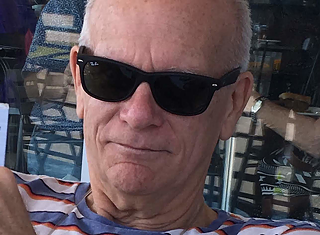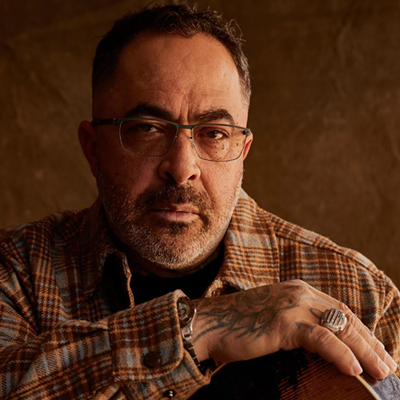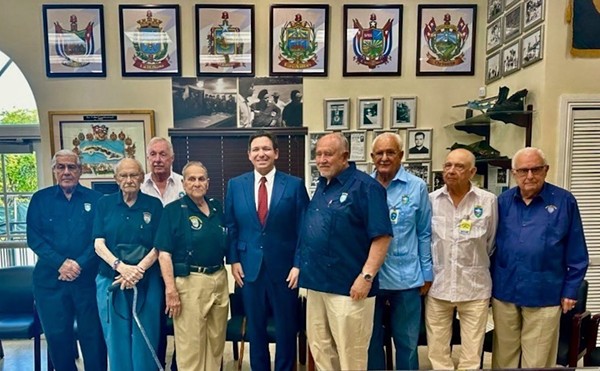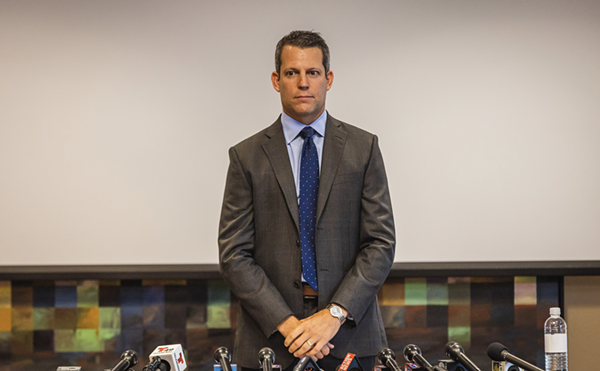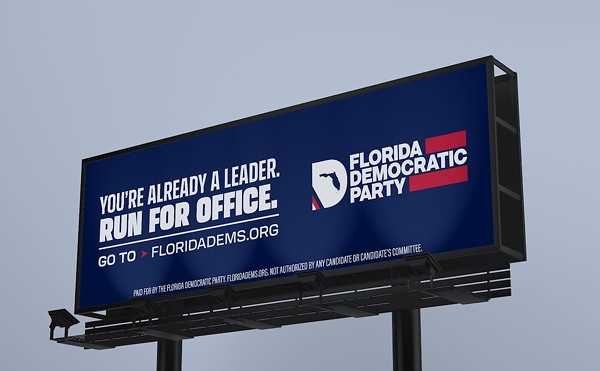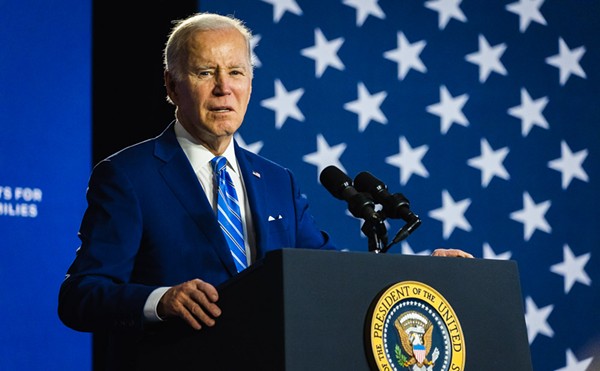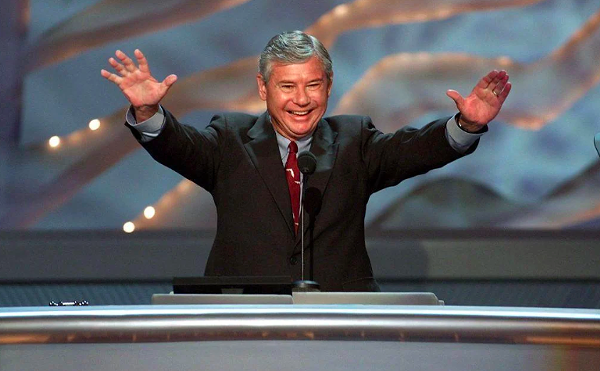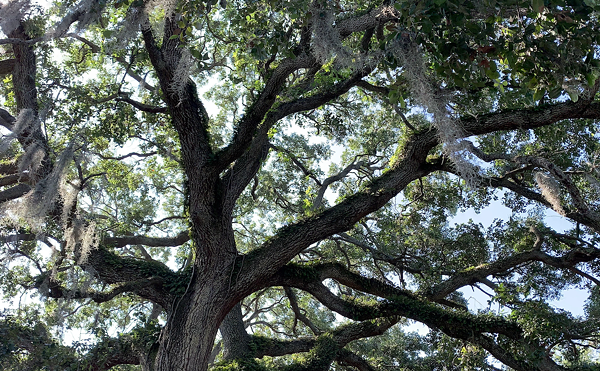With each clap of thunder, you could feel shivers run down the spines of nightclub owners. Jonathan Cordeau, a manager at Twilight on Seventh Avenue, listened to the downpour on a recent Saturday afternoon. "You can see your profits flowing down the streets in the rain," he mused.With a nightlife scene that's built on Thursday/Friday/Saturday business — and with Thursday and Friday markedly off — a washed-out Ybor City Saturday is indeed a sobering thought.
As it turns out, disaster was averted. By early evening, the winter cold front had cleared. The air turned crisp. People came and got drunk. Just not enough of them.
At 2 a.m., Twilight owner Robert Solomon gazed down onto Seventh from his club's balcony, sipped his Stoli and OJ, and said, "This is the slowest Saturday down here in a while."
His tone didn't have the ring of doom, probably because he is committed to making Twilight a live-music showcase for national and local acts — with events throughout the week. Saturday night anxieties are more apt to stay high for the strip's many drinking emporiums, like Club Hedo across the street, which hires comely young ladies to tote sandwich boards touting cut-rate cocktails.
Ybor City, Tampa's after-dark boomtown during the '90s, is in a slump. Business is off, foot traffic has slowed — so goes the refrain from bar and restaurant owners up and down the street. "I've heard people say by as much as 50 percent," says Solomon, whose year-old Twilight occupies what was once The Rubb.The days of Ybor City serving as the area's Party Central are over. Formidable competition has sprung up: the Channelside District, just a short trolley ride away; South Howard Avenue, with its string of tony restaurants and nightspots; International Plaza's upscale promenade; the resurgence of downtown St. Petersburg, spurred by the BayWalk complex. These places have stolen much of Ybor's most coveted clientele — folks with money and the willingness to spend it.
"These days, the street has become the party," Cordeau says. "Or kids can come down to Ybor with $15, park, get hammered on drink specials and still have money for Denny's."
Tampa Police Lt. Russ Marcotrigiano, a supervisor in the district, estimates the typical Ybor weekend crowd is 18-25 years old, and doesn't start arriving en masse until after 11 p.m. By then, he says, middle-age couples and families have long since fled, clearing way for the bacchanal.
Some Ybor defenders attribute the district's troubles to outside forces. They point to an economy in the dumper, a lingering post-Sept. 11 malaise and war jitters as reasons crowds have diminished. But it's unlikely you'd hear the same woe from bustling BayWalk. Vince Pardo, president of the city-affiliated Ybor City Development Corporation (YCDC), says he detected a "dramatic decrease in Friday night business," when BayWalk opened in November 2000.
Thursday nights once lured 350-400 to Flytrap, a dark alternative club. When attendance dwindled to "10 or 15," it closed on Thursdays, says manager Sandi Hein. Flytrap is in the midst of renovations and will reopen in early March as the HooDoo Room, with a bigger emphasis on live original music.
Seventh Avenue on weekend nights reverberates with a palpable sense of desperation. Many clubs are cutting each other's throats with price come-ons, giving little thought to their entertainment product. Most nightspots house DJs who spin mainstream rap and Top 40. A few book cover bands. "A lot of the clubs now have no soul," says Joe Gomez, co-owner of Cherry's, a Seventh Avenue restaurant/bar.
Echoes Cordeau: "What does it say when you go out to a nightclub and have the same experience you could at a pool party?"
Such a lowest-common-denominator strategy may have worked in the '90s, when officials routinely estimated that 30,000-40,000 partiers would flock to Ybor on an average weekend. That's plenty of thirsty folk to go around. With current crowd estimates ranging from 10,000-20,000, though, it's readily apparent that the strip has become an environment of haves and have-nots.
At midnight on a recent Friday, three-tiered Prana sported a long line to get in. Many headed toward the roof, where a band played reggae and Island music. Folks also queued up for Amphitheater; the techno music throbbed and the lights swirled and the mob on the dancefloor looked as if they were collectively holding each other up.
Hip-hop kids waited outside to enter Fuel. The crowded Empire, another rap club, emanated a creeping sense of hostility. A bouncer who saw me jotting in my notebook approached. "What are you writing that down for?" he barked over the bass-heavy din. "Don't worry, I'm not a cop," I replied, handing him a business card. He eyed it, looked me up and down and walked away. (Then I wondered what he would've done if I was a cop.)
As for the have-nots, Friday midnight at Platforms found about 20 folks dancing to Michael Jackson's "Billie Jean." The Realm, owned by strip-club maven Joe Redner, barely seemed open at all. "We lose money there," he says flatly. The Boneyard had a smattering of patrons drinking beer and playing pool. At the Blue Shark, a blues group played to a modest crowd. Same with the funky cover band at the Rare Olive.
It doesn't take an MBA to suss it out: Ybor City simply can no longer sustain this many bars. On the rain-threatened Saturday, 25 clubs were in operation on five blocks of Seventh Avenue.
The attrition is underway. Pleasuredome, Tahiti Joe's and Bar Tampa (word on the street says it will reopen soon as a new venue) were all closed, rendering the westernmost 14th Street block clubless (and no longer cordoned off to vehicles). Fat Tuesday, Inferno, Turbulence and Marty's Blues Café were also dark. Further closings pulse through the district's rumor mill.
So will Ybor City sink or swim?
Many of the historic district's most passionate advocates see some hope, or at least opportunity, amid the gloom. The time may be right to begin making over the party Mecca into a diversified community that incorporates a variety of retail, cultural and residential offerings. And bars too. It could emerge as Tampa's true urban enclave, one that doesn't only bustle on selected nights but moves to a variety of rhythms all the time.
"It's poetic justice that the bars are struggling," says Marcie Hoffman Porges, who owns the Hoffman Porges Gallery on Seventh Avenue. "But I don't buy into revenge. I think (the slump) was inevitable. But I still think Ybor City can be a great arts district with a lot of clubs, small businesses and coffeehouses. The city just needs to be more sophisticated in their decision-making. You don't make policy to promote a three-nights-a-week community."
'Bars are what built Ybor," says Tessa Shiver, who co-owns the Don Vicente de Ybor Historic Inn and lives on Seventh Avenue. She's right — about the current Ybor, anyway. Once a thriving neighborhood and workplace for Tampa's cigar workers, the district fell on hard times after World War II, when the cigar industry declined and residents migrated to other areas of Tampa. By the 1960s, many of the shotgun shacks and decrepit storefronts had been leveled during an urban renewal movement. It turned out to be more like urban removal. For decades, Ybor City has been heavily pocked with vacant lots.Hillsborough Community College set up a campus in 1974, lending an element of rejuvenation, but the vibe at night was bleak and threatening. Only the venerable Columbia Restaurant brought in crowds, who scurried back to their cars after dinner.
But a certain faction saw an opportunity. Artists, attracted by large, loft-like spaces, cheap rents and the district's distinctly old-urban ambience, set up studios and residences. Ybor gradually developed into boho-ville. Unique events like the Artists & Writers Ball, the underground's answer to Gasparilla, and WMNF's Tropical Heatwave cropped up. A few eateries and watering holes opened to cater to the artistically inclined. "In the early '80s, you had the Columbia on one end (of Seventh) and El Goya (once Tampa's dominant gay nightclub) on the other," Pardo of YCDC says. "We used to talk about filling in the center."
In 1990, Ybor City was named a National Historic Landmark, one of four in Florida. Two years earlier, it had been granted status by the city as a Community Redevelopment Area. This enabled the district to keep property taxes generated by its growth to use toward further development.
Funky independent shops like La France vintage clothing, Three Birds Bookstore and Blue Chair Music drew a counterculture clientele. Nighttime activity grew to include poetry readings, small theater, art auctions and mosh-heavy punk-rock shows. Boho-ville was getting bigger.
Ybor habitués liked the pace, but the city saw a chance to really jumpstart its long-blighted Latin Quarter. To spur growth, it offered a set of incentives to entice business people into the historic district. The rule requiring bars to be 1,000 feet apart was set aside. Stringent standards for keeping stormwater on site were dropped. Fees for businesses that did not provide parking were waived. So were transportation impact fees, which require each new business to pay for the traffic it dumps into surrounding roads.
The business sector that found these incentives most attractive? Bar owners. They swarmed Tampa City Council requesting "wet zonings," which permit alcohol to be served in a particular building.
The council complied, handing out wet zonings like Jolly Ranchers on Halloween. Nightclub owners, after all, came with the dough and inclination to refurbish dilapidated buildings. "If it was not for the relaxation of wet zonings, a lot of the buildings would have never been fixed up," Pardo says. Even so, few local pols gave much thought to what the historic district might become.
Linda Saul-Sena, who currently sits on the City Council, was also a member in the late '80s. As prospective bar owners paraded in front of the dais to get their go-ahead to sell liquor, she was incredulous. Backed by a handful of the district's artist/activists, she and council member Scott Paine urged caution. But the council wielded its rubber stamp, consistently voting 5-2 in favor of new wet zonings.
"It became a why-not thing," Saul-Sena says. "We approved the first 20, why not approve the next 20? There was this sense of profit potential."
"Neither the council nor the mayor was inclined to exert control over a place that was generating a lot of revenues, pushing up real estate values and filling empty spaces," says urban planner Michael English, an early participant in Ybor's artist renaissance.
What resulted was growth without a long-term clue. The Ybor development agency's Community Redevelopment Plan, ratified in 1988 and expiring in June, encouraged growing the "commercial core." It did not, however, recommend filling the place with bars.
Nineteen ninety one. Consensus says it was Year One of the Ybor gold rush. Nightclub owners played connect-the-dots along Seventh Avenue. And the hordes came. Along with them came a sense of civic pride. For a town like Tampa with longstanding identity problems about its status as a major city, a thriving entertainment district seemed to prove that it was in the same league as New Orleans and Miami and Seattle. In 1995, the city closed several blocks of Seventh to cars, cementing the district's status as a party zone.And, for quite a few years, it was really fun. A panoply of folk congregated in Ybor to revel in the distractions. Those not inclined to simply drink till they fell down could take in live music at the Blues Ship, the Jazz Cellar, the Rubb and other clubs. They could gather in more intimate places like Atomic Age Cafe and Lounge, Z-Spot and Ovo Cafe.
Storefronts sprung to life: From 1990 to 1996, 130 new businesses opened in Ybor; 50 opened in '94 alone.
It wasn't just about letting the good times roll, though. The city, which opened the floodgates without much of a blueprint, was slow to deal with surging problems: Garbage pickup wasn't adequate; crowd management was a struggle; the noise ordinance became a divisive issue.
Except for a hearty few, the artist colony bailed. Rents had more than doubled, and the hassle factor had increased exponentially. Worse, Ybor City's bohemian identity vanished. Brad Cooper still runs his spacious Brad Cooper Gallery next door to Green Iguana. An early Ybor pioneer who set up an apartment adjacent to his business, he eventually had to vacate due to health problems. "I developed a sleep disorder," he says. Many of the district's unique shops and small eateries were forced out due to skyrocketing rents. Blues Ship, Jazz Cellar, The Rubb and other live-music clubs folded.
Around the turn of the millennium, Ybor City no longer deserved to be called an entertainment district. A drinking mall, maybe.
To its credit, the city has taken a more proactive role in Ybor in recent years, with varying degrees of success. The place is spiffier now, thanks in large part to a city-generated "Clean Team," which picks up litter.Centro Ybor, a $40-million mall hailed by Mayor Dick Greco as the final piece in the Ybor puzzle, opened in October 2000. But the facility has experienced extended growing pains. While some of its businesses, like the Improv comedy club, attract crowds and add to the cultural fabric, more places struggle. Chain stores like American Eagle and Pac Sun represent the kind of overt commercialism that was disdained in the district. Many of Centro Ybor's 20 movie theaters sit nearly empty.
Parking used to be a nightmare in Ybor. As more and more cars clogged in, owners of vacant lots gouged customers for $10 and up. The district now includes two well-lighted municipal garages that charge modest fees. Pardo claims that parking problems in Ybor City effectively "no longer exist." The new streetcar that runs between Channelside, downtown and Ybor adds a quaint element, as well as convenient transportation.
At the same time, the city has made some bonehead moves with regard to the district. During much of the mid '90s heyday, Ybor's streets were peppered with small vendors and street performers, which added to the overall vibrancy. In '98, the city shut the small guys out. District denizens can understand why little merchants were eliminated to protect storefront businesses (although they may not agree) but still wonder why the guy with the plastic paint cans can't set 'em up and drum away. Losing the buskers sucked some of the freaky character out of the strip.
The city also set up surveillance cameras equipped with futuristic imaging software, which for a time turned Ybor City into a national poster village for Big Brother.
Then there's the case of Cherry's. For years, it stayed open after the bars closed at 3 to serve food (but no alcohol) to revelers. That hour or so represented 10-15 percent of Cherry's weekly sales, says co-owner Jeff Gruendel. About a year ago, the cops put a stop to it. Gruendel tried to mitigate the loss by delivering food to bar employees after closing, until he got jumped by a wasted 20-year-old, who bashed in his head with a broken beer mug.
"The way I see it, a drunk, hungry person can walk over to Cherry's and eat a burger," Gruendel says. "It's just another drunk who's not on the road right away. I just don't understand."
Many, if not most, of the nightclubs in Ybor City are technically in breach of their liquor licenses.Florida law says license holders must be open "at least eight hours a day for a period of 210 days or more" during a year — that's about four days a week. Many of the bars are only open from 10 p.m. to 3 a.m. on prime nights. If the law were to be suddenly enforced, Thursday-to-Saturday haunts like Harpo's, Full Moon Saloon and Empire (all closed on a recent Wednesday) would have to open an extra night and fight for business when it's even slower.
This could lead to further attrition in the bar ranks, which sits well with proponents of Ybor City becoming a true mixed-use community. Rents might come down. More indie retail could come in. People might move back to the upstairs apartments on the strip.
Such developments, while still a wish list, would build upon a few of Ybor City's encouraging trends. Lunch business has stayed largely strong. The Hilton Garden Inn on Ninth Avenue is heavily booked. A 138-room Hampton Inn has been approved and should break ground this year. Pardo is most encouraged by a new wave of residential development. He envisions lots of people living on the blocks within walking distance of Seventh.
So could it happen? Could Ybor City become more than just a three-nights-a-week hangout and lunch haven? Maybe. But it might be awhile. On Feb. 20, the City Council had to decide whether to approve the opening of another 18-and-up nightclub, this one with a planned firefighters theme, in a long-abandoned storefront on Seventh that sits between two other bars.
The answer: Yes.
The vote: 5-2. (Saul-Sena was one of the "no" votes.)
"It took a mighty long time to turn this thing around the first time," says Alan Kahana, who owns land and several nightclubs in Ybor but advocates more diversity in the historic district. "We're not going to turn it around again tomorrow."
Contact Senior Writer Eric Snider at 813-248-8888, ext. 114, or [email protected].


